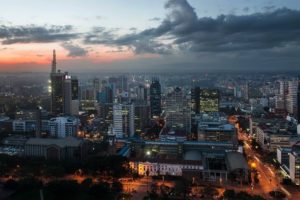Motorists will now pay a fee of between 75 Kenyan Shillings and 100 Kenyan Shillings every hour they park their vehicles in the Nairobi City Centre. That is if a new policy being proposed by the City Hall gets implemented.

Any parking on spaces that are off the streets will cost motorists 100 Kenyan Shillings for every hour their vehicles are parked. This is part of the moves by the County government to adequately utilize the intense competition going on for the available parking spots, while also ensuring that the traffic is reduced. Off street spaces are usually preferred by motorists because they offer significantly more safety for their vehicles against possible vandalism and even theft.
For on street parking spaces south of Kenyatta Avenue and the west of Moi Avenue, motorists will pay 90 Kenyan Shillings per hour. Said areas are considered to be the most sought after parking spaces by motorists.
With regards with parking in order areas that are seperate from the two prime spots, they will incur a parking fee of 75 Kenyan Shillings per hour. As it currently stands motorists are charged a flat fee of 200 Kenyan Shillings every day, for on street parking in the Nairobi City Centre.
For parking in hubs outside of the Nairobi City Centre, motorists will have to part with 50 Kenyan Shillings every hour. Other parking areas will attract a charge of 40 Kenyan Shillings per hour.
According to the policy document, “This is aimed at fully regulating all parking in the city centre where there is a high level of competition for the available spaces.”

The policy is also looking to remove the option of seasonal tickets for parking in the Nairobi City Centre. It instead, wants the seasonal ticket offer to be offered outside of the City Centre at a fee of 6,000 Kenyan Shillings per month.
This will result in the regulation of parking vehicles in mixed areas which have major traffic volumes, as well as areas or hubs that are in high demand. It will however not apply to the highways that cross or pass said areas.
The areas include Hurlingham, Ngara, Gigiri, Karen, Eastleigh, Yaya Centre, Westlands, Community, and Upper Hill.
The policy document states that, “In these areas, regulation is needed to guarantee urban quality and to provide chances of sustainable means of transport.”
For the areas which are being regulated the price will direct mirror the demand, along with the extent to which the supply can meet the demand.
Included in the policy document is a statement which reads, “In the regulated areas, parking on public spaces has a price. The price is higher, the longer the parking duration.”

In the Nairobi City Centre and the areas which surround houses and shopping centers the parking periods, will be from 8am to 8pm. As for the other regulated areas the parking periods will be from 8am to 6pm.
A report by the Nairobi Assembly Public Accounts Committee in 2019 made it known, that for the financial year which ended on the 30th of June 2017 a total of 1,305,440 vehicles were parked in the 6,125 slots during the particular financial year which was reviewed. Of the 1,305,440 vehicles, only 402,401 vehicles which constitutes 31 percent, paid the parking fees.
City Hall was only able to collect 1.55 billion Kenyan Shillings in revenue from parking charges during the financial year that ended on the 30th of June 2020. Said sum was significantly lower than the initial target which was 2.8 Billion Kenyan Shillings and resulted in a performance of 53 percent.
In the financial year under review City Hall was able to attain 4.1 Billion Kenyan Shillings which is 24.8 percent at the completion of the first half of the fiscal year that ended on the 30th of June 2021. This was significantly lower than the annual target of 16.5 Billion Kenyan Shillings that was set.

Parking fees during the period brought about a return of 685 million Kenyan Shillings from the annual target that was 2.8 billion Kenyan Shillings representing, 24.5 percent of the target.
The Nairobi County government is in addition, proposing the provision of parking for all residents in housing developments and apartment developments in the City Centre via the permits of residents. For residents who reside outside the City Centre and in mixed areas, they will be allowed to purchase season tickets.
Entrances into areas that are regulated, will be marked with signs and or road markings in order to provide precise information like the payment mode and the fares while making sure, that the point where a user or motorist would be leaving the controlled parking zone is clear and easy to identify.
In the words contained within the policy document, “It must be clear to the public where parking is regulated and where not, using road signs and markings.”

Nairobi County will also be providing solutions which will be fashioned towards catering to parking for taxis through the reduction of the number of taxis that stay idle in the city centre, and the provision of taxi ranks.
Certain parking areas specifically for “official” vehicles, will be defined by the City Hall. For unloading and loading bays said areas will be situated close to commercial premises.
The policy is proposing the designation of not less than two (2) percent of all parking spaces for ensuring the smooth mobility of anyone living with disabilities. Said designated parking spaces or bays will be sized appropriately and situated at locations that are easily accessible.
The Nairobi City Hall will be setting up charging points for electric vehicles at a number of parking spaces. It will also be setting aside streets and or areas where high goods vehicles will be allowed to park.
How informative was this article? Are there any other news topics, categories, or How To topics, that you would like us to write on? Feel free to reach out to Mpesa Pay in the comment section.


